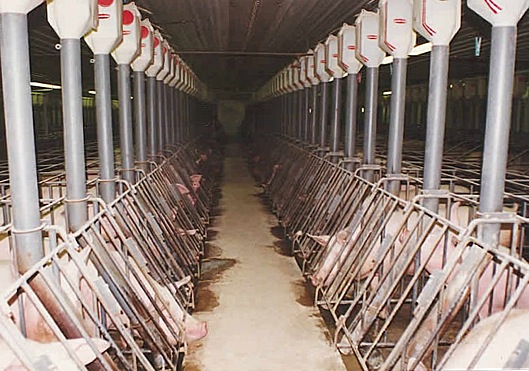 Image above: Inside a typical pig farm production factory. Very unsustainable farming. From (http://animalblawg.wordpress.com/2010/02/03/ohio-issue-2-aftermath).
By Brent Blackwelder on 3 October 2010 in SteadyState.org -
(http://steadystate.org/food-and-agriculture-in-a-steady-state-economy)
Image above: Inside a typical pig farm production factory. Very unsustainable farming. From (http://animalblawg.wordpress.com/2010/02/03/ohio-issue-2-aftermath).
By Brent Blackwelder on 3 October 2010 in SteadyState.org -
(http://steadystate.org/food-and-agriculture-in-a-steady-state-economy)
The annual book festival of the Library of Congress just featured Jonathan Safran Foer who spoke about his book Eating Animals. He writes about his grandmother who survived World War II on the run from the Germans, scavenging from garbage cans and always on the verge of starvation. However, she refused to eat a piece of pork given her by a kindly farmer because “if nothing matters, nothing is worth saving.”
This fall (what better time than harvest season?), I will focus my Daly News essays on the ethics and policies that would characterize food production in a steady state economy. These essays will offer answers to questions such as: What would people eat and how would it be grown? Would almost everyone be a vegetarian or vegan? Would genetically engineered food play a big role? What about farm subsidies and the role of biofuels? How many of the current agricultural practices in the United States would even continue as part of a steady state economy?
Since sustainable scale is the most important feature of a steady state economy (i.e., the economy must fit within the capacity of the ecosystems that contain it), the first issue to investigate is how environmental systems are responding to agricultural practices – in particular, the effects of agricultural practices on climate. There is growing evidence that animal agriculture is the number one cause of global climate destabilization, contributing more than all global transport put together. Former World Bank ecologist Robert Goodland has produced an analysis showing that at least half of the human-caused greenhouse gases come from the production of domesticated animals. Livestock and their byproducts account for over 32.5 billion tons of carbon dioxide a year, or roughly 51% of annual worldwide greenhouse gases (see Worldwatch Nov./Dec. 2009).
Here is the unsettling irony: factory-farm dominated agriculture, as a major climate destabilizer, is creating long-term weather changes that compromise the ability of the earth to produce food.
Plant ecologists estimate that for every 1 degree Celsius temperature increase, grain yields drop 10%. Climate disruption has led to serious melting of snowpacks and glaciers in most places. In the Western U.S. where snowpacks store about 75% of the water supply, the Natural Resources Defense Council reports that climate change could reduce this to 40% by 2060. Similar concerns exist for the great Asian rivers like the Ganges and the Mekong that originate in the Tibetan plateau.
These impacts are not being imposed on a planet whose soils and grasslands are in wonderful condition and whose groundwater has been safeguarded and not pumped beyond recharge. These impacts are not being imposed on a planet whose human population has stabilized but rather is likely to reach 9-11 billion by 2050.
In contrast to this grim picture of the agricultural capacity of the planet, many encouraging trends in food production are emerging. Examples include growth of organic food consumption, expansion of farmers markets, the local food movement, the slow food movement, the food-miles movement, and initiatives to get healthy food into schools – all of which are heading in promising directions.
A steady state economy would bolster these trends. It would move away from control of food by transnational corporations and toward an increased number and diversity of small and medium-sized farms, and healthy rural communities. Revamped agricultural systems would provide many varieties of food in ways that conserve soil and water and maintain long-term fertility of the land.
These promising developments are taking place not because of, but in spite of, the U.S. Department of Agriculture, which has for the most part been a giant promoter of animal slum operations and presider over the demise of the family farm.
Over 10 million animals are slaughtered for food each year in the U.S. in factory slum operations that produce over 95% of the nation’s meat. It is abundantly clear that meat-dominated megafarm agriculture is not sustainable (even from the climate/energy standpoint alone), and it could not be part of the food system in a steady state economy.
A steady state economy would not feature perverse subsidies as a cornerstone of the economy. Yet in the U.S. a curious mathematical formula governs the dispensing of subsidies: the more environmentally damaging and harmful to public health the practice or project, the larger the state and federal handouts.
Thus, industrial agriculture enjoys all sorts of subsidies from the Farm Bill. Its extensive use of energy-intensive pesticides and fertilizers is supported by the numerous subsidies the fossil fuel industry receives. Gigantic animal factory slums not only get subsidized, but they externalize their environmental and health costs onto their neighbors and the public. Time magazine documented the competition among states to see who could dole out the most tax money to lure one of these animal slum operations into their state. In contrast, the encouraging trends in agriculture that I cited receive very little governmental support.
Note: CASSE also has a briefing paper on the topic of agriculture in a steady state economy.
.
1 comment :
"a volcano that could blow at any day"
that is the problem with disaster fantacysts - even when they may be right, they still sound like collapse porn beaters.
Post a Comment